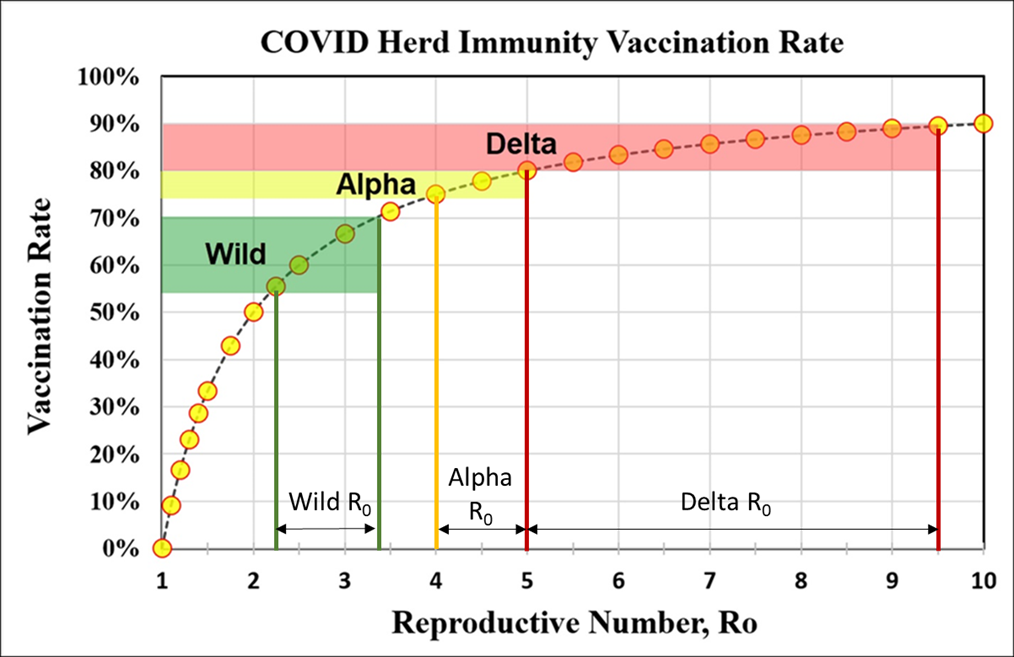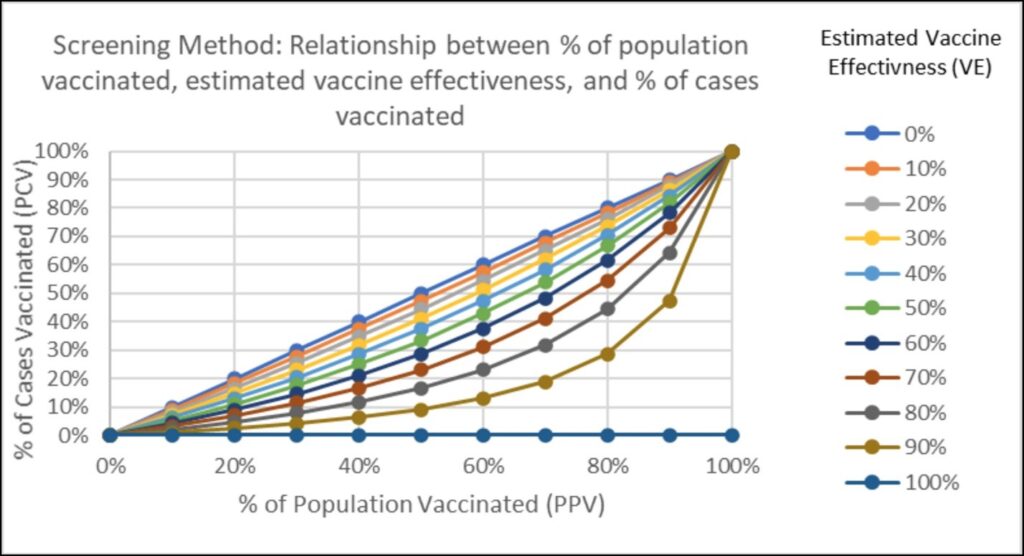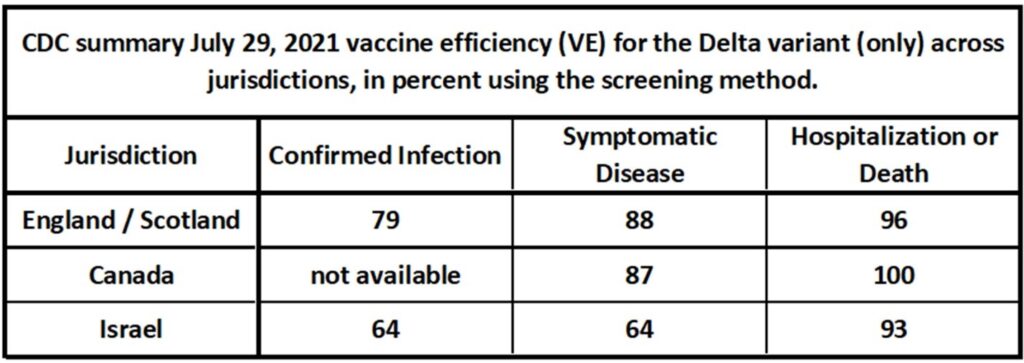A July 29, 2021, report from the U.S. Centers for Disease Control and Prevention (CDC) indicates that the Delta variant of the COVID-19 virus may be as transmissible as chickenpox.[1] The internal report, obtained and published by the Washington Post,[2] claims that the variant is likely more severe, may be more transmissible by the vaccinated than expected, and advises that certain restrictions be reconsidered.
The report also discusses the importance of understanding vaccine effectiveness (VE) and breakthrough cases, which are infections contracted by vaccinated people.
Let us summarize this report and explain certain aspects of vaccine effectiveness (VE) that could be helpful in understanding this and future reports concerning the attempt to control COVID through vaccines.
CDC Internal Report Summary[3]
- The Delta variant has a reproductive rate (R0) of between 5 and 9.5
- Vaccinated persons who contract the Delta variant (breakthrough cases) may be as likely to infect others as unvaccinated persons who contract the Delta variant
- VE estimates are averaged, but VE specific to individuals is controlled by multiple variables, including age and “immunocompromising conditions”
- The Delta variant is “likely” more severe than previous strains
- There is more than one way to consider VE: its effectiveness against hospitalization and/or death, against symptomatic illness, or against infection
- VE is highest against hospitalization/death and lower for less severe outcomes
- Vaccine breakthrough cases may reduce public confidence in vaccines
- Suggested prevention strategies could include universal masking and other interventions
Implications of a new range for R0
In a recent article Examining the effectiveness of restrictions and the path to COVID eradication, we explained the concept of basic reproduction rate R0. R0 is the initial, basic, or pristine reproductive rate. It defines the disease’s infectious potential, though not its severity. It is the key variable to understand in determining the herd immunity vaccination rate. R0 is the number of secondary infections that are generated from an initial case prior to any element of the population becoming immune and prior to any mitigation strategies.[4]
R0 is also very difficult to estimate and should be treated as highly uncertain.[5]
The relationship between R0 and herd immunity vaccination rate (V/N), under the assumption of high vaccination effectiveness, is given in the formula:
![]()
If we accept the new range for R0 from the CDC, the COVID herd immunity vaccination rate for the Delta variant is estimated at between 80 and 89.5%. A summary chart comparing COVID variants is shown below.

Chart showing the relationship between the R0 of various COVID variants and the herd immunity vaccination rate, using the new R0 range from the July 29, 2021, CDC report for the Delta variant. The Delta variant could require vaccination rates as high as 89.5%.
Implications that breakthrough cases may spread Delta
The possibility that the Delta variant R0 may be higher than other strains and that even vaccinated/infected individuals could be significant spreaders introduce the possibility for the re-imposition of non-pharmaceutical interventions (NPIs), or restrictions, for the masses –including the vaccinated – in outbreak situations. The CDC report says that NPIs are “essential” in such scenarios, implying the assumption that interventions are effective and that the public will comply. The CDC suggests that in a Delta variant outbreak, universal mask wearing might be suggested.[6]
The reinstatement of any such restrictions will involve an understanding of the effectiveness of the potential restrictions and public and political will. [7]
What is vaccine effectiveness?
Vaccine effectiveness is a relative measure, defined as “The percentage reduction in the incidence of disease among vaccinated persons compared with unvaccinated persons.”[8] This measure is not, therefore, an absolute measure. It is relative, and it does not tell the incidence (or attack rate) that a disease occurs in the vaccinated group.
The vaccine effectiveness method that is currently used by governments and the CDC is called the screening method. This method is quite simple and uses readily available, commonly collected data.[9]The CDC discusses this method in their report, along with its concerns about communication regarding vaccine effectiveness. These concerns stem from potential misunderstandings by media and the general public in the context of vaccine effectiveness and breakthrough case numbers. Let’s look at this context in more detail, so that BIG Media readers are not among the confused.
The screening method requires the following data from a particular region during a particular time period:
- The proportion of vaccinated amongst total COVID infections – PCV
- The proportion of unvaccinated amongst total COVID infections – PCU (100%-PCV)
- The proportion of the population vaccinated – PPV.
The formula for the VE estimate from this method is:
Using this equation and a realistic set of inputs: PCV = 30%, PCU = 70%, and PPV = 70%, the vaccine effectiveness is 81.6%. The chart below from the CDC shows how the PCV, or percentage of those vaccinated among total COVID cases, varies with the percentage of the population vaccinated, given different assumptions of vaccine effectiveness.

The related percentage of cases of COVID in vaccinated persons (PCV) versus the percentage of the population that is vaccinated (PPV) given a specific vaccine effectiveness (VE). PCV must increase as PPV increases, even for high vaccine effectiveness.
There have been several news reports since COVID vaccinations have been available to the public that cite only the PCV number. Taken out of context, this number is at best misleading, and at worst alarming, because it increases as more people get vaccinated. CDC’s concern is that the public will interpret this as an indication that the vaccine does not work.
Unless the vaccine is 100% effective, a small percentage of people vaccinated will contract the disease. These are the breakthrough cases. As more people are vaccinated, the total number of breakthrough cases will increase. Pfizer reports an incidence rate (of the original COVID strain) among those vaccinated of 0.037% (with a VE of 95.1%).[11]
As more people are vaccinated, and the total cases decrease as a result, the proportion of vaccinated among the cases will rise as illustrated in the conceptual chart shown below. PCV is the relative proportion of red to (red + blue), which increases as PPV, the percentage of the population vaccinated, rises. When a news article reports that 80% of new cases of COVID are among the vaccinated, keep this relationship in mind to put that number in context.

Conceptual chart showing the relative proportion of new cases of COVID as the percentage of the population vaccinated increases (x-axis), and the total cases decreases. As the percentage of the population vaccinated increases, the percentage of new cases that come from the vaccinated group also increases.
The CDC’s VE summary
The CDC’s VE summary (shown in the table below) shows some regional variation in the estimates of the effectiveness of vaccines (Pfizer, in this case) against the Delta variant. These estimates use the screening method and consider confirmed cases of the Delta variant only, and therefore represent the VE of the two-dose Pfizer vaccine in preventing Delta.
Israel’s 64% number for symptomatic disease is well below that of Canada and England/Scotland. These variations could be as a result of different vaccination protocols or could be related to Israel having vaccinated its population earlier.[12]. A new result from Israel, reported by Forbes, suggests that the VE against Delta may be significantly lower for mild cases (about 40%), but still above 90% against severe illness. There are some questions regarding the techniques used in this latest study and potential bias, according to Forbes.[13]

The vaccine efficiency (VE) estimates for two doses of Pfizer against the Delta variant across jurisdictions shows that vaccine appears materially effective, particularly against the most severe outcomes. Israel’s lower effectiveness for less severe cases should be noted.
Interpretation
The CDC report cites numerous other published reports, and uses preliminary data and internal analysis that may change and should be scrutinized. As we explained earlier, estimating R0 is very difficult and is subject to large uncertainty. [14] VE numbers, the estimates of the relative severity of the Delta variant and its likelihood of being easily spreadable from even the vaccinated infected (breakthrough cases) are only as good as the public health data from which they are derived. Therefore, these estimates vary and are subject to change as new data arrives.
For VE estimates, it is important to note that accuracy is likely higher for hospitalization and deaths than for more mild outcomes of infection. The different VE estimates across different jurisdictions globally also suggests that effectiveness is a multi-variate phenomenon and should be considered carefully. This could lead to third doses of vaccines to those who are immunocompromised or are older.[15]
Regardless of these challenges and questions, the VE against COVID, and even the Delta variant, appears significant, particularly against severe outcomes.
The apparent transmissibility of the Delta variant may continue to cause outbreaks and can spread from vaccinated persons. This could see the reinstitution of restrictions in some jurisdictions, depending on the severity of the outbreak and the political will regarding disease control.
References
[1] Centers for Disease Control Prevention (CDC), July 29, 2021, Improving Communications around vaccine breakthrough and vaccine effectiveness
[2] Abutaleb, Yasmeen, Carolyn Johnson and Joel Achenbach, July 29, 2021, ‘The war has changed’: Internal CDC document urges new messaging, warns delta infections likely more severe
[3] Centers for Disease Control Prevention (CDC), July 29, 2021, Improving Communications around vaccine breakthrough and vaccine effectiveness
[4] Hunt, Lee, July 27, 2021, Examining the effectiveness of restrictions and the path to COVID eradication
[5] Hunt, Lee, July 27, 2021, Examining the effectiveness of restrictions and the path to COVID eradication
[6] Centers for Disease Control Prevention (CDC), July 29, 2021, Improving Communications around vaccine breakthrough and vaccine effectiveness
[7] Hunt, Lee, July 27, 2021, Examining the effectiveness of restrictions and the path to COVID eradication
[8] Cohen, Adam et al, 2012, An Assessment of the Screening Method to Evaluate Vaccine Effectiveness: The Case of 7-Valent Pneumococcal Conjugate Vaccine in the United States, PLOS ONE
[9] Cohen, Adam et al, 2012, An Assessment of the Screening Method to Evaluate Vaccine Effectiveness: The Case of 7-Valent Pneumococcal Conjugate Vaccine in the United States, PLOS ONE
[10] Cohen, Adam et al, 2012, An Assessment of the Screening Method to Evaluate Vaccine Effectiveness: The Case of 7-Valent Pneumococcal Conjugate Vaccine in the United States, PLOS ONE
[11] Polack, Fernando et al, 2020, Safety and Efficacy of the BNT1622 mRNA Covid-19 Vaccine, New England Journal of Medicine, 2020, 383:2603-2615
[12] Hart, Robert, July 23, 2021, Pfizer Shot just 39% Effective Against the Delta Infection, But Largely Prevents Severe Illness, Israel Study Suggests, Forbes
[13] Hart, Robert, July 23, 2021, Pfizer Shot just 39% Effective Against the Delta Infection, But Largely Prevents Severe Illness, Israel Study Suggests, Forbes
[14] Hunt, Lee, July 27, 2021, Examining the effectiveness of restrictions and the path to COVID eradication
[15] Hart, Robert, July 23, 2021, Pfizer Shot just 39% Effective Against the Delta Infection, But Largely Prevents Severe Illness, Israel Study Suggests, Forbes
(Lee Hunt – BIG Media Ltd., 2021)

 [10]
[10]

Timely article. I confess I did a double take on reading some of the initial media headlines regarding the CDC report before diving into details. This helps flesh out the meaning behind the conclusions.
Thanks, Edward. The CDC report had a tremendous amount of detail in it. There was a synthesis of a great many other reports plus their own analysis. How this gets boiled down in media articles is a whole other question though, isn’t it?